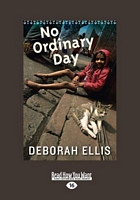- Welcome to FictionDB, Guest
- | My Account
- | Help

No Ordinary Day — Deborah Ellis

Shortlisted for the SYRCA 2013 Diamond Willow Award, selected as an American Library Association 2012 Notable Children's Book, a Booklist Editors' Choice, nominated for the OLA Golden Oak Tree Award, and a finalist for the Ruth and Sylvia Schwartz Children's Book Awards: Young Adult/Middle Reader Award, the Governor General's Literary Awards: Children's Text and the Canadian Library Association Book of the Year for Children Award
There's not much that upsets young Valli. Even though her days are spent picking coal and fighting with her cousins, life in the coal town of Jharia, India, is the only life she knows. The only sight that fills her with terror are the monsters who live on the other side of the train tracks -- the lepers. Valli and the other children throw stones at them. No matter how hard her life is, she tells herself, at least she will never be one of them.
Then she discovers that she is not living with family after all, that her "aunt" was a stranger who was paid money to take Valli off her own family's hands. She decides to leave Jharia … and so begins a series of adventures that takes her to Kolkata, the city of the gods.
It's not so bad. Valli finds that she really doesn't need much to live. She can "borrow" the things she needs and then pass them on to people who need them more than she does. It helps that though her bare feet become raw wounds as she makes her way around the city, she somehow feels no pain. But when she happens to meet a doctor on the ghats by the river, Valli learns that she has leprosy. Despite being given a chance to receive medical care, she cannot bear the thought that she is one of those monsters she has always feared, and she flees, to an uncertain life on the street.
Correlates to the Common Core State Standards in English Language Arts:
CCSS.ELA-LITERACY.RL.4.3
Describe in depth a character, setting, or event in a story or drama, drawing on specific details in the text (e.g., a character's thoughts, words, or actions).
CCSS.ELA-LITERACY.RL.5.3
Compare and contrast two or more characters, settings, or events in a story or drama, drawing on specific details in the text (e.g., how characters interact).
CCSS.ELA-LITERACY.RL.6.6
Explain how an author develops the point of view of the narrator or speaker in a text.
There's not much that upsets young Valli. Even though her days are spent picking coal and fighting with her cousins, life in the coal town of Jharia, India, is the only life she knows. The only sight that fills her with terror are the monsters who live on the other side of the train tracks -- the lepers. Valli and the other children throw stones at them. No matter how hard her life is, she tells herself, at least she will never be one of them.
Then she discovers that she is not living with family after all, that her "aunt" was a stranger who was paid money to take Valli off her own family's hands. She decides to leave Jharia … and so begins a series of adventures that takes her to Kolkata, the city of the gods.
It's not so bad. Valli finds that she really doesn't need much to live. She can "borrow" the things she needs and then pass them on to people who need them more than she does. It helps that though her bare feet become raw wounds as she makes her way around the city, she somehow feels no pain. But when she happens to meet a doctor on the ghats by the river, Valli learns that she has leprosy. Despite being given a chance to receive medical care, she cannot bear the thought that she is one of those monsters she has always feared, and she flees, to an uncertain life on the street.
Correlates to the Common Core State Standards in English Language Arts:
CCSS.ELA-LITERACY.RL.4.3
Describe in depth a character, setting, or event in a story or drama, drawing on specific details in the text (e.g., a character's thoughts, words, or actions).
CCSS.ELA-LITERACY.RL.5.3
Compare and contrast two or more characters, settings, or events in a story or drama, drawing on specific details in the text (e.g., how characters interact).
CCSS.ELA-LITERACY.RL.6.6
Explain how an author develops the point of view of the narrator or speaker in a text.
Age Level
Genres
Click on any of the links above to see more books like this one.
- 2013 West Virginia Children's Book Award -- Children's (Winner)
- 2011 Governor General's Literary Award -- Children's Literature (Finalist)
- 2011 Booklist -- Starred Review (*)
- 2011 Horn Book Magazine -- Starred Review (*)
- 2011 School Library Journal -- Starred Review (*)
- 2012 Junior Library Guild -- Selection (*)



